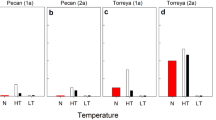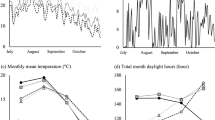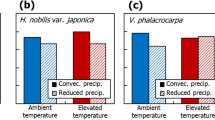Abstract
In mountainous regions, inversion situations with cold-air pools in the valleys occur frequently, especially in fall and winter. With the accumulation of inversion days, trees in lower elevations experience lower temperature sums than those in middle elevations. In a two-year observational study, deciduous trees, such as Acer pseudoplatanus and Fagus sylvatica, on altitudinal transects responded in their fall leaf senescence phenology. Phenological phases were advanced and senescence duration was shortened by the cold temperatures in the valley. This effect was more distinct for late phases than for early phases since they experienced more inversion days. The higher the inversion frequency, the stronger the signal was. Acer pseudoplatanus proved to be more sensitive to cold temperatures compared to Fagus sylvatica. We conclude that cold-air pools have a considerable impact on the vegetation period of deciduous trees. Considering this effect, trees in the mid hillside slopes gain advantages compared to lower elevations. Our findings will help to improve knowledge about ecological drivers and responses in mountainous forest ecosystems.








Similar content being viewed by others
References
Archetti M, Richardson AD, O’Keefe J, Delpierre N (2013) Predicting climate change impacts on the amount and duration of autumn colors in a New England forest. PLoS One 8(3):e57373. doi:10.1371/journal.pone.0057373
Bader DC, McKee TB (1985) Effects of shear, stability and valley characteristics on the destruction of temperature inversions. J Clim Appl Meteorol 24:822–832. doi:10.1175/1520-0450(1985)024<0822:EOSSAV>2.0.CO;2
Bastian O, Steinhardt U (2002) Development and perspectives of landscape ecology. Kluwer Academic Publishers, Dordrecht
Baumgartner A (1962) Die Lufttemperatur als Standortfaktor am Gr. Falkenstein (Bayer. Wald). Forstwiss Centralbl 81:18–47. doi:10.1007/BF01821588
Buchanan-Wollaston V, Earl S, Harrison E, Mathas E, Navabpour S, Page T, Pink D (2003) The molecular analysis of leaf senescence—a genomics approach. Plant Biotech J 1:3–22. doi:10.1046/j.1467-7652.2003.00004.x
Burg SP, Burg EA (1962) Role of ethylene in fruit ripening. Plant Physiol 37(2):179–189
Caffarra A, Donnelly A (2011) The ecological significance of phenology in four different tree species: effects of light and temperature on bud burst. Int J Biometeorol 55:711–721. doi:10.1007/s00484-010-0386-1
Cao J, Jiang F, Sodmergen CK (2003) Time-course of programmed cell death during leaf senescence in Eucommia ulmoides. J Plant Res 116:7–12. doi:10.1007/s10265-002-0063-5
Chmielewski FM, Rötzer T (2001) Response of tree phenology to climate change across Europe. Agr Forest Meteorol 108:101–112. doi:10.1016/S0168-1923(01)00233-7
Cleland EE, Chuine I, Menzel A, Mooney HA, Schwartz MD (2007) Shifting plant phenology in response to global change. Trends Ecol Evol 22(7):357–365. doi:10.1016/j.tree.2007.04.003
Čufar K, Luis M, Saz MA, Črepinšek Z, Kajfež-Bogataj L (2012) Temporal shifts in leaf phenology of beech (Fagus sylvatica) depend on elevation. Trees 26:1091–1100. doi:10.1007/s00468-012-0686-7
Daubert K (1962) Ein Beitrag zur Kenntnis der Bodeninversionen. Meteorol Rundsch 15:121–130
Delpierre N, Dufrêne E, Soudani K, Ulrich E, Cecchini S, Boé J, François C (2009) Modelling interannual and spatial variability of leaf senescence for three deciduous tree species in France. Agr Forest Meteorol 149:938–948. doi:10.1016/j.agrformet.2008.11.014
Dittmar C, Elling W (2006) Phenological phases of common beech (Fagus sylvatica L.) and their dependence on region and altitude in Southern Germany. Eur J Forest Res 125:181–188. doi:10.1007/s10342-005-0099-x
Dittmar C, Fricke W, Elling W (2006) Impact of late frost events on radial growth of common beech (Fagus sylvatica L.) in Southern Germany. Eur J Forest Res 125:249–259. doi:10.1007/s10342-005-0098-y
Dragoni D, Schmid HP, Wayson CA, Potter H, Grimmond CSB, Randolph JC (2011) Evidence of increased net ecosystem productivity associated with a longer vegetated season in a deciduous forest in south-central Indiana, USA. Glob Change Biol 17:886–897. doi:10.1111/j.1365-2486.2010.02281.x
Dufrêne E, Davi H, Franҫois C, Gl M, Dantec VL, Granier A (2005) Modelling carbon and water cycles in a beech forest: Part I: Model description and uncertainty analysis on modelled NEE. Ecol Model 185:407–436. doi:10.1016/j.ecolmodel.2005.01.004
DWD (2011) Deutschlandwetter im November 2011. German Meteorological Service (DWD), Offenbach
Estrella N, Menzel A (2006) Responses of leaf colouring in four deciduous tree species to climate and weather in Germany. Climate Res 32:253–267. doi:10.3354/cr032253
Fang JY, Yoda K (1988) Climate and vegetation in China (I). Changes in the altitudinal lapse rate of temperature and distribution of sea level temperature. Ecol Res 3:37–51. doi:10.1007/BF02348693
Finn GA, Straszewski AE, Peterson V (2007) A general growth stage key for describing trees and woody plants. Ann Appl Biol 151:127–131. doi:10.1111/j.1744-7348.2007.00159.x
Fracheboud Y, Luquez V, Björkén L, Sjödin A, Tuominen H, Jansson S (2009) The control of autumn senescence in European Aspen. Plant Physiol 149:1982–1991. doi:10.1104/pp.108.133249
Gu L, Hanson PJ, Mac Post W, Kaiser DP, Yang B, Nemani R, Pallardy SG, Meyers T (2008) The 2007 eastern US spring freezes: Increased cold damage in a warming world? Bioscience 58:253–262. doi:10.1641/B580311
Hänninen H (1991) Does climatic warming increase the risk of frost damage in northern trees? Plant Cell Environ 14:449–454. doi:10.1111/j.1365-3040.1991.tb01514.x
Hänninen H (1996) Effects of climatic warming on northern trees: testing the frost damage hypothesis with meteorological data from Provenance transfer experiments. Scand J Forest Res 11:17–25. doi:10.1080/02827589609382908
Hastic T (2013) Package ‘gam’ generalized additive models. The comprehensive R archive network. Published online: http://cran.r-project.org/. Accessed 19 July 2013
Heide OM (2003) High autumn temperature delays spring bud burst in boreal trees, counterbalancing the effect of climatic warming. Tree Physiol 23:931–936. doi:10.1093/treephys/23.13.931
Heide OM (1993) Dormancy release in beech buds (Fagus sylvatica) requires both chilling and long days. Physiol Plantarum 89:187–191. doi:10.1111/j.1399-3054.1993.tb01804.x
Jolly WM, Nemani R, Running SW (2005) A generalized, bioclimatic index to predict foliar phenology in response to climate. Glob Change Biol 11:619–632. doi:10.1111/j.1365-2486.2005.00930.x
Jonsson AM, Linderson ML, Stjernquist I, Schlyter P, Barring L (2004) Climate change and the effect of temperature backlashes causing frost damage in Picea abies. Global Planet Change 44:195–207. doi:10.1016/j.gloplacha.2004.06.012
Kaiser A (1992) Analyse der vertikalen Temperaturstruktur im Zillertal anhand von Fesselballon-, Sodar- und Hangmessungen. Ber FBVA 67:51–64
Kirchner M, Faus-Kessler T, Jakobi G, Leuchner M, Ries L, Scheel HE, Suppan P (2012) Altitudinal temperature lapse rates in an Alpine valley: trends and the influence of season and weather patterns. Int J Climatol 33:539–555. doi:10.1002/joc.3444
Kramer K (1994) A modelling analysis of the effects of climatic warming on the probability of spring frost damage to tree species in the Netherlands and Germany. Plant Cell Environ 17:367–377. doi:10.1111/j.1365-3040.1994.tb00305.x
Levitt J (1980) Responses of plants to environmental stresses. Academic Press, New York
Lim PO, Kim HJ, Gil Nam H (2007) Leaf senescence. Annu Rev Plant Biol 58:115–136. doi:10.1146/annurev.arplant.57.032905.105316
Lim PO, Woo HR, Nam HG (2003) Molecular genetics of leaf senescence in Arabidopsis. Trends Plant Sci 8:272–278. doi:10.1016/S1360-1385(03)00103-1
Linkosalo T, Carter TR, Häkkinen R, Hari P (2000) Spring phenology and frost damage risk of Betula sp. under climatic warming. Tree Physiol 20(17):1175–1182. doi:10.1093/treephys/20.17.1175
Machalek A (1974) Inversionsuntersuchungen in einem Gebirgstal. Wetter und Leben 26:157–168
Meier U (1997) Growth stages of mono- and dicotyledonous plants. Blackwell, Berlin
Meining S, van Wilpert K, Schröter H, Augustin N, Kramer P (2011) Waldzustandsbericht 2011. Forstliche Versuchs- und Forschungsanstalt Baden-Württemberg (FVA), Freiburg, pp 12–28
Menzel A (1997) Phänologie von Waldbäumen unter sich ändernden Klimabedingungen—Auswertung der Beobachtungen in den Internationalen Phänologischen Gärten und Möglichkeiten der Modellierung von Phänodaten. Forstliche Forschungsberichte München 164
Menzel A, Fabian P (1999) Growing season extended in Europe. Nature 397:659. doi:10.1038/17709
Menzel A, Fabian P (2001) Veränderungen der forstlichen Vegetationszeit in den letzten Jahrzehnten in Deutschland. Beitr Forstwirtsch Landschaftsökol 35:188–191
Menzel A, Leuchner M, Schuster C, Renner S, Gröger A, Friedmann A, Korch O, Kirchner M, Jakobi G (2013) KLIMAGRAD—Auswirkungen des Klimawandels in den Alpen— Erfassung mittels Höhengradienten. Endbericht Januar 2013. Bayerisches Staatsministerium für Umwelt und Gesundheit, Munich
Micu D (2009) Snow pack in the Romanian Carpathians under changing climatic conditions. Meteorol Atmos Phys 105:1–16. doi:10.1007/s00703-009-0035-6
Nam HG (1997) The molecular genetic analysis of leaf senescence. Curr Opin Biotech 8:200–207. doi:10.1016/S0958-1669(97)80103-6
Noodén LD, Guiamét JJ, John I (1997) Senescence mechanisms. Physiol Plantarum 101:746–753. doi:10.1111/j.1399-3054.1997.tb01059.x
Pepin NC (2001) Lapse rate changes in northern England. Theor Appl Climatol 68:1–16. doi:10.1007/s007040170049
Pepin NC, Seidel DJ (2005) A global comparison of surface and free-air temperatures at high elevations. J Geophys Res: Atmospheres 110. doi: 10.1029/2004JD005047
Piao S, Ciais P, Friedlingstein P, Peylin P, Reichstein M, Luyssaert S, Margolis H, Fang J, Barr A, Chen A, Grelle A, Hollinger DY, Laurila T, Lindroth A, Richardson AD, Vesala T (2008) Net carbon dioxide losses of northern ecosystems in response to autumn warming. Nature 451:49–52. doi:10.1038/nature06444
R Development Core Team (2009) R: a language and environment for statistical computing. R Foundation for Statistical Computing, Vienna
Reiter R, Kanter H-J (1972) Das Klima des Wank. Ergebnisse einer rund 10-jährigen klimatologischen Messserie in 1780 m NN. Wissenschaftliche Mitteilungen der Physikalisch-Bioklimatischen Forschungsstelle der Fraunhofer Gesellschaft 7
Richardson AD, Bailey AS, Denny EG, Martin CW, O’Keefe J (2006) Phenology of a northern hardwood forest canopy. Glob Change Biol 12:1174–1188. doi:10.1111/j.1365-2486.2006.01164.x
Rolland C (2003) Spatial and seasonal variations of air temperature lapse rates in alpine regions. J Clim 16:1032–1046. doi:10.1175/1520-0442(2003)016<1032:SASVOA>2.0.CO;2
Röthlisberger J (2010) Früher Frühling - früher Herbst? Beobachtungen und Reflexionen zur Herbstphänologie. Bauhinia 22:93–110
Sauberer F, Dirmhirn I (1954) Über die Entstehung der extremen Temperaturminima in der Doline Gstettner-Alm. Arch Meteor Geophy B 5:307–326. doi:10.1007/BF02242757
Seyfert F (1970) Phänologische Studien aus dem Erzgebirge. Abh Meteorol Dienst DDR Nr 91. Akademie Verlag, Berlin
Smart CM (1994) Gene expression during leaf senescence. New Phytol 126:419–448. doi:10.1111/j.1469-8137.1994.tb04243.x
Schuster C, Estrella N, Menzel A (2013) Shifting and extension of phenological periods with increasing temperature along altitudinal transects in southern Bavaria. Plant Biol. doi:10.1111/plb.12071
Sparks TH, Menzel A (2002) Observed changes in seasons: an overview. Int J Climatol 22:1715–1725. doi:10.1002/joc.821
Taylor G, Tallis MJ, Giardina CP, Percy KE, Miglietta F, Gupta PS, Gioli B, Calfapietra C, Gielen B, Kubiske ME, Scarascia-Mugnozza GE, Kets K, Long SP, Karnosky DF (2008) Future atmospheric CO2 leads to delayed autumnal senescence. Glob Change Biol 14:264–275. doi:10.1111/j.1365-2486.2007.01473.x
Thomas H, Stoddart JL (1980) Leaf senescence. Annu Rev Plant Phys 31:83–111. doi:10.1146/annurev.pp. 31.060180.000503
Vitasse Y, Basler D (2013) What role for photoperiod in the bud burst phenology of European beech. Eur J Forest Res 132:1–8. doi:10.1007/s10342-012-0661-2
Vitasse Y, Franҫois C, Delpierre N, Dufrêne E, Kremer A, Chuine I, Delzon S (2011) Assessing the effects of climate change on the phenology of European temperate trees. Agr Forest Meteorol 151:969–980. doi:10.1016/j.agrformet.2011.03.003
Vitasse Y, Porte AJ, Kremer A, Michalet R, Delzon S (2009) Responses of canopy duration to temperature changes in four temperate tree species: relative contributions of spring and autumn leaf phenology. Oecologia 161:187–198. doi:10.1007/s00442-009-1363-4
Wareing PF (1956) Photoperiodism in woody plants. Ann Rev Plant Physio 7:191–214. doi:10.1146/annurev.pp. 07.060156.001203
Wareing PF (1953) Growth studies in woody species V. Photoperiodism in dormant buds of Fagus sylvatica L. Physiol Plantarum 6:692–706. doi:10.1111/j.1399-3054.1953.tb08442.x
Wegener M (2006) KLIMA: Schwitzen am »kältesten Punkt Deutschlands«, Wetterzentrale Forum Archiv 2006 3. Quartal. http://www.wetterzentrale.de/cgi-bin/webbbs/wzarchive2006_3.pl?noframes;read=926929. Accessed 4 February 2013
Werner H, Kirchner M, Welzl G, Hangartner M (1999) Ozone measurements along vertical transects in the Alps. Env Sci Pollut R 6:83–87. doi:10.1007/BF02987554
Williams RF (1955) Redistribution of mineral elements during development. Annu Rev Plant Physiol 6:25–42. doi:10.1146/annurev.pp. 06.060155.000325
Wu C, Gonsamo A, Chen JM, Kurz WA, Price DT, Lafleur PM, Jassal RS, Dragoni D, Bohrer G, Gough CM, Verma SB, Suyker AE, Munger JW (2012) Interannual and spatial impacts of phenological transitions, growing season length, and spring and autumn temperatures on carbon sequestration: A North America flux data synthesis. Global Planet Change 92–93:179–190. doi:10.1016/j.gloplacha.2012.05.021
Yang X, Mustard JF, Tang J, Xu H (2012) Regional-scale phenology modeling based on meteorological records and remote sensing observations. J Geophys Res: Biogeosciences 117, G03029. doi:10.1029/2012JG001977
Ziegler C (2011) Auswirkung der Fruktifikation auf den Zuwachs der Buche. In: Waldzustandsbericht 2011 – Bericht über den ökologischen Zustand des Waldes in NRW, Ministerium für Klimaschutz, Umwelt, Landwirtschaft, Natur und Verbraucherschutz des Landes Nordrhein-Westfalen, Düsseldorf, Germany, pp 32–55
Acknowledgements
Our gratitude is directed to the Bavarian State Ministry of the Environment and Public Health for funding the project “Auswirkungen des Klimawandels in den Alpen—Erfassung mittels Höhengradienten” (KLIMAGRAD; Climate Change Impact Monitoring at Altitudinal Gradients) within the “Klimaprogramm Bayern 2020”. The research leading to these results has received funding from the European Research Council under the European Union’s Seventh Framework Program (FP7/2007-2013) / ERC grant agreement n° [282250]. The authors furthermore acknowledge the support by the Bavarian State Forest Enterprise and the German Meteorological Service (DWD) for the provision of additional data.
Author information
Authors and Affiliations
Corresponding author
Electronic supplementary material
Below is the link to the electronic supplementary material.
ESM 1
(PDF 397 kb)
Rights and permissions
About this article
Cite this article
Schuster, C., Kirchner, M., Jakobi, G. et al. Frequency of inversions affects senescence phenology of Acer pseudoplatanus and Fagus sylvatica . Int J Biometeorol 58, 485–498 (2014). https://doi.org/10.1007/s00484-013-0709-0
Received:
Revised:
Accepted:
Published:
Issue Date:
DOI: https://doi.org/10.1007/s00484-013-0709-0




